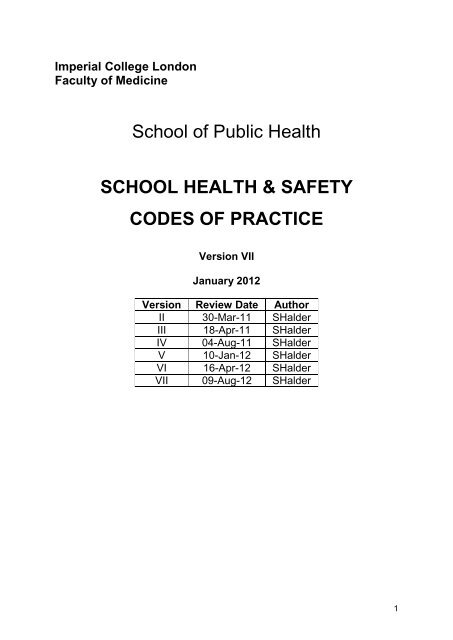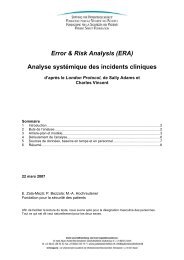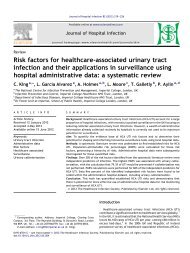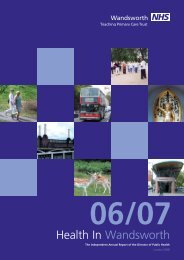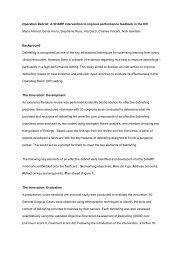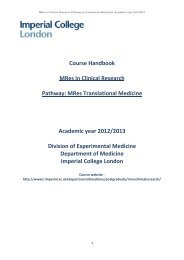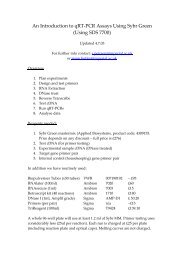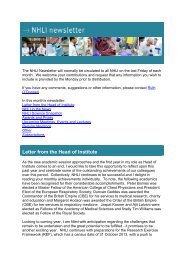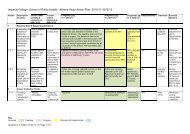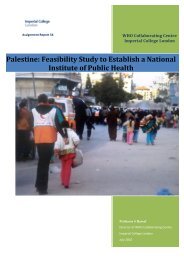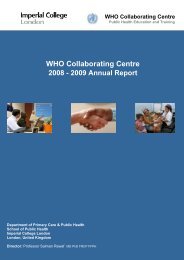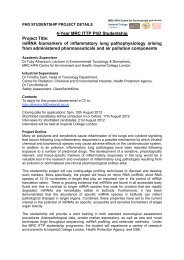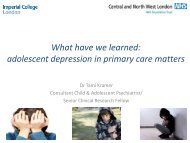school health & safety codes of practice - Imperial College School of ...
school health & safety codes of practice - Imperial College School of ...
school health & safety codes of practice - Imperial College School of ...
You also want an ePaper? Increase the reach of your titles
YUMPU automatically turns print PDFs into web optimized ePapers that Google loves.
<strong>Imperial</strong> <strong>College</strong> London<br />
Faculty <strong>of</strong> Medicine<br />
<strong>School</strong> <strong>of</strong> Public Health<br />
SCHOOL HEALTH & SAFETY<br />
CODES OF PRACTICE<br />
Version VII<br />
January 2012<br />
Version Review Date Author<br />
II 30-Mar-11 SHalder<br />
III 18-Apr-11 SHalder<br />
IV 04-Aug-11 SHalder<br />
V 10-Jan-12 SHalder<br />
VI 16-Apr-12 SHalder<br />
VII 09-Aug-12 SHalder<br />
1
Contents<br />
1 INTRODUCTION 3<br />
1.1 Safety Management Responsibilities 3<br />
1.2 Campus Arrangements 3<br />
1.3 <strong>School</strong> Arrangements 4<br />
2 SCHOOL ARRANGMENTS 4<br />
2.1 Safety Management 4<br />
2.2 Governance 5<br />
3 AT DEPARTMENTAL LEVEL 6<br />
3.1 Organisation 6<br />
3.1.1 Safety Personnel 7<br />
3.2 Arrangements 7<br />
3.2.1 Risk Assessment and Risk control and Monitoring <strong>of</strong> Risk Control 7<br />
3.2.2 Off Site Work 9<br />
Page<br />
3.2.3 Occupational Health Assessments and Surveillance 10<br />
3.2.4 Communication and consultation arrangements 11<br />
3.2.5 Training and competence assurance procedures 11<br />
3.2.6 Audit, Inspection and Review 12<br />
3.2.7 Out <strong>of</strong> hours and lone working 13<br />
3.2.8 Fire, Accidents, Emergencies and Contingency Planning 13<br />
3.2.9 New and Expectant Mothers 16<br />
3.2.10 Document Management 16<br />
4 APPENDIXES 18<br />
Appendix 1 - <strong>School</strong> Safety Structure 18<br />
Appendix 2 - <strong>School</strong> Health and Safety Committee Membership 10-11 20<br />
Appendix 3 - <strong>School</strong> Health and Safety Committee - Terms <strong>of</strong> Reference 21<br />
Appendix 4 - Declaration 24<br />
2
1 INTRODUCTION<br />
Welcome to the <strong>School</strong> <strong>of</strong> Public Health, please read and understand this document, it is<br />
intended to help you to comply with the <strong>safety</strong> rules <strong>of</strong> the <strong>College</strong> and the <strong>School</strong>. Once you<br />
have read this document, please return the declaration at the end to your line manager or<br />
<strong>safety</strong> personnel within your department.<br />
<strong>Imperial</strong> <strong>College</strong> (as an employer) has a legal duty to protect the <strong>health</strong>, <strong>safety</strong> and welfare<br />
<strong>of</strong> all its employees, students, visitors and anyone who may be affected by the activities <strong>of</strong><br />
the <strong>College</strong>. In order to achieve compliance with <strong>health</strong> and <strong>safety</strong> legislation the <strong>College</strong><br />
has developed a number <strong>of</strong> <strong>health</strong> and <strong>safety</strong> policies, which can be found at:<br />
http://www3.imperial.ac.uk/<strong>safety</strong>/policies/<br />
1.1 Safety Management and Responsibilities<br />
The <strong>College</strong> Health and Safety Structure and Responsibilities Policy:<br />
http://www3.imperial.ac.uk/<strong>safety</strong>/policies/organisationandarrangements<br />
Identifies the <strong>health</strong> and <strong>safety</strong> responsibilities <strong>of</strong> all individuals who have an association with<br />
the <strong>College</strong>. The responsibilities vary according to the individual’s role (e.g. principal<br />
investigators, staff, students, visitors, contractors etc); and all individuals should be aware <strong>of</strong><br />
their own responsibilities with regards to <strong>health</strong> and <strong>safety</strong> for e.g.; PI’s/academic<br />
supervisors are expected to ensure that all <strong>of</strong> their workers receive adequate training to<br />
enable then to fulfil their roles.<br />
Health and <strong>safety</strong> law is policed by various enforcing authorities including the <strong>health</strong> and<br />
<strong>safety</strong> executive and the environment agency. If <strong>Imperial</strong>’s policies and systems are found to<br />
be inadequate, the <strong>College</strong> can be taken to court and fined. There are also penalties in law<br />
for individuals who fail to comply with <strong>health</strong> and <strong>safety</strong> legislation, and non-compliance with<br />
<strong>College</strong> policies could result in disciplinary action or dismissal; fines or imprisonment.<br />
Where staff or students do not feel confident that they can carry out a work activity safely<br />
they should seek help and advice (from their line manager or departmental <strong>safety</strong><br />
coordinator (DSC) or from the relevant campus <strong>safety</strong> manager (CSM) or the Safety<br />
Department/Occupational Health rather than compromise their own <strong>safety</strong> or that <strong>of</strong> others.<br />
1.2 Campus Arrangements<br />
Following the review <strong>of</strong> academic and administrative structures which was undertaken by the<br />
Faculty <strong>of</strong> Medicine at the end <strong>of</strong> 2009, a new top level <strong>health</strong> and <strong>safety</strong> review and<br />
monitoring structure has been introduced. The new structure is based on a Campus support<br />
model – the aim <strong>of</strong> which is to increase assurance that all activities on a campus where<br />
Faculty <strong>of</strong> Medicine staff are present are being coordinated and monitored in a consistent<br />
and holistic manner and to ensure that areas <strong>of</strong> interface (both internally among Faculty<br />
<strong>School</strong>s/Institutes/Departments and with Campus partners (including other Faculties, the<br />
NHS, MRC and industry partners) are effectively and safely managed.<br />
3
1.3 <strong>School</strong> Arrangements<br />
Under the Health and Safety at Work Etc. Act 1974 and under the <strong>College</strong>’s Health and<br />
Safety Policies, the Head <strong>of</strong> <strong>School</strong> is responsible to the Faculty Principal for the<br />
management <strong>of</strong> <strong>health</strong> and <strong>safety</strong> in the <strong>School</strong> and for the <strong>safety</strong> <strong>of</strong> all staff reporting to him.<br />
To this end, the Head <strong>of</strong> <strong>School</strong> has put in place systems to ensure that the Heads <strong>of</strong><br />
Departments are aware <strong>of</strong> their individual responsibilities. This includes the appointment <strong>of</strong> a<br />
<strong>School</strong> Health and Safety Committee, which is chaired by a senior member <strong>of</strong> academic<br />
staff, and meets termly; and the introduction <strong>of</strong> a uniform <strong>School</strong> Health and Safety Policy,<br />
the arrangements <strong>of</strong> which are outlined in this Code <strong>of</strong> Practice. The <strong>School</strong> Code <strong>of</strong><br />
Practice will be reviewed annually and auditing and inspection shall be carried out by the<br />
Campus Health and Safety Managers on a regular basis.<br />
Within Departments, the Head <strong>of</strong> Department and line managers are responsible for <strong>health</strong><br />
and <strong>safety</strong>.<br />
2 SCHOOL ARRANGEMENTS<br />
2.1 Safety Management<br />
The Head <strong>of</strong> the <strong>School</strong> <strong>of</strong> Public Health expects all members <strong>of</strong> staff to actively project<br />
<strong>safety</strong> management across all sites and to bring best <strong>practice</strong> to all departments.<br />
The Head <strong>of</strong> <strong>School</strong> has appointed various <strong>safety</strong> personnel and provide them with<br />
adequate resources (time, training and finance) and will support any decisions and actions<br />
taken by them. The <strong>safety</strong> personnel are part <strong>of</strong> the management structure and a <strong>School</strong><br />
<strong>safety</strong> structure (appendix 1). The Campus Health & Safety Managers (CSM’s), as<br />
appointed by the Faculty <strong>of</strong> Medicine, will work closely with the Head <strong>of</strong> <strong>School</strong>, Deputy<br />
<strong>School</strong> Manager, <strong>School</strong> Health and Safety Committee, Heads <strong>of</strong> Departments, and<br />
Departmental Safety Co-ordinators (DSC’s), as appointed by the Head <strong>of</strong> Departments.<br />
S/he can advise <strong>school</strong> staff and students on all aspects <strong>of</strong> <strong>health</strong> and <strong>safety</strong> management<br />
and risk assessments.<br />
In addition, the Head <strong>of</strong> each Department will appoint <strong>safety</strong> personnel to reflect all the<br />
hazards within their department. For example if GM, radiation and/or <strong>of</strong>f site work are<br />
undertaken within a department, then the Head <strong>of</strong> the Department will appoint a GM <strong>safety</strong><br />
advisor, radiation protection supervisor, and/or <strong>of</strong>f site work coordinator as appropriate.<br />
It is expected that where a department undertakes work that is relatively low risk in nature<br />
(e.g. in departments where all workers are <strong>of</strong>fice based, and the department is not involved<br />
in <strong>of</strong>f-site or laboratory work or other higher risk activities etc) then the department must<br />
appoint a departmental <strong>safety</strong> coordinator whose primary function would be to act as the<br />
display screen assessor and primary contact on <strong>health</strong> and <strong>safety</strong> issues for the department,<br />
a fire warden and if appropriate a first aider.<br />
Where a department is split over several campuses the department must appoint a <strong>safety</strong><br />
coordinator, a fire warden and a first aider if appropriate for each campus. It is possible that<br />
4
that the same person can fulfil all three roles where small numbers <strong>of</strong> workers are located;<br />
but deputies should be appointed as appropriate.<br />
The <strong>School</strong> has established a Health and Safety Committee (appendix 2), which will meet<br />
termly to discuss <strong>health</strong> and <strong>safety</strong> issues. The Head <strong>of</strong> <strong>School</strong> or a nominated senior<br />
member <strong>of</strong> academic staff will chair the Committee. Membership should represent the entire<br />
<strong>School</strong> with a balance <strong>of</strong> academic (PI’s), lab managers, technical, clerical, students, and<br />
manual workers (if apt) amongst its members; and will be attended by all departmental<br />
<strong>safety</strong> representatives. The function <strong>of</strong> the Health and Safety Committee (see Terms <strong>of</strong><br />
Reference- appendix 3) is to receive, review and monitor:<br />
� Reports <strong>of</strong> accidents, near misses, or work related problems.<br />
� Reports from <strong>School</strong>/Departmental/Campus Safety personnel.<br />
� The results <strong>of</strong> internal inspections by departmental <strong>safety</strong> coordinators and any external<br />
audits and inspections carried out by the CSM, or HSE etc.<br />
� Staff training.<br />
� Provisions for Occupational Health issues including First Aid, Display Screen Equipment<br />
and Health Surveillance, etc.<br />
The <strong>School</strong> Health and Safety Committee should make recommendations to Head <strong>of</strong><br />
<strong>School</strong> on:<br />
� Improvements in <strong>School</strong> <strong>health</strong> and <strong>safety</strong> standards.<br />
� Actions to minimise accidents or near misses or work related ill <strong>health</strong>.<br />
� Local arrangements for implementing new <strong>College</strong> statutory requirements or policies.<br />
A fixed agenda (see appendix 2) should be used; minutes should be circulated to all staff<br />
within the <strong>School</strong>. In addition, <strong>health</strong> and <strong>safety</strong> should be a regular agenda item at all<br />
<strong>School</strong> meetings e.g. executive meetings, any senior staff meetings and research committee<br />
meetings, departmental or laboratory meetings, in addition to the <strong>School</strong> Health and Safety<br />
Committee meeting.<br />
2.2 Governance<br />
As detailed under the relevant <strong>College</strong> Policies (http://www3.imperial.ac.uk/<strong>safety</strong>/policies)<br />
The <strong>School</strong> is responsible for the governance <strong>of</strong> the following areas:<br />
� Risk Assessment and Risk control and Monitoring <strong>of</strong> Risk Control Procedures<br />
� Occupational Heath Assessments and Surveillance<br />
� Communication and Consultation Arrangements<br />
� Training, Competence and Supervision assurance procedures<br />
� Safety performance and measurement and standards<br />
� Workplace <strong>safety</strong><br />
� Fire, accidents and emergencies and contingency planning<br />
� Off site working<br />
5
� Out <strong>of</strong> hours and lone working.<br />
� Biological Agents and Genetically-Modified Micro-Organisms<br />
� Genetic Modification<br />
� Carcinogens, Human Toxins and Toxic Chemicals<br />
� Non-Ionising and Ionising Radiation<br />
� New and Expectant Mothers<br />
� Manual Handling<br />
� Local Exhaust Ventilation<br />
� Compressed Gases<br />
� Vaccination<br />
� Health protection <strong>of</strong> all workers within the <strong>School</strong><br />
� Non standard work places.<br />
� Document management<br />
� The <strong>School</strong> will comply with the 1998 Data Protection Act and <strong>College</strong> policy regarding<br />
the retention <strong>of</strong> data.<br />
The following documents will be retained by the <strong>School</strong>:<br />
� Minutes from the <strong>School</strong> Health and Safety Committee.<br />
� Safety audit and inspection reports.<br />
� Membership <strong>of</strong> Committees.<br />
� Letters from enforcing bodies.<br />
� Annual Safety Reports to Safety Council.<br />
� Risk Register.<br />
Audit, inspection and review<br />
� The departmental <strong>safety</strong> coordinator should inspect the department termly prior to the<br />
<strong>School</strong> H&S committee meeting, and submit inspection reports to the committee<br />
secretary prior to committee meetings.<br />
� The CSM will also undertake annual inspections and audits <strong>of</strong> Departments and/or the<br />
<strong>School</strong>.<br />
� Results <strong>of</strong> any inspections and audits will be forwarded and discussed with the Head <strong>of</strong><br />
the Department and the Head <strong>of</strong> <strong>School</strong> as appropriate.<br />
� Findings should be acted upon as soon as reasonably practicable, or immediately if the<br />
risk necessitates it.<br />
3 AT DEPARTMENT LEVEL<br />
3.1 Organisation<br />
The <strong>School</strong> has six Departments:<br />
� Department <strong>of</strong> Epidemiology and Biostatistics<br />
� Department <strong>of</strong> Primary Care and Public Health<br />
� Department <strong>of</strong> Infectious Disease Epidemiology<br />
� Department <strong>of</strong> Genomics <strong>of</strong> Common Disease<br />
� <strong>Imperial</strong> Clinical Trials Unit<br />
� Neuroepidemiology and Ageing Research Unit<br />
6
Each Department operates over a specific campus (with the exception <strong>of</strong> the Clinical Trials<br />
Unit which operates across campuses). It is expected that <strong>health</strong> and <strong>safety</strong> will be a<br />
standard item on agendas for routine meetings.<br />
3.1.1 Safety Personnel<br />
The Head <strong>of</strong> Department will appoint various <strong>safety</strong> personnel (as detailed in section 2.1.1)<br />
and provide them with adequate resources (time, training and finance) and support decisions<br />
and actions taken by them.<br />
It is expected that where a department undertakes work that is relatively low risk in nature<br />
(e.g. in departments where all workers are <strong>of</strong>fice based, and the department is not involved<br />
in <strong>of</strong>f-site or laboratory work or other higher risk activities etc) then the department must<br />
appoint a <strong>safety</strong> coordinator (whose primary function would be to act as the display screen<br />
assessor and primary contact on <strong>health</strong> and <strong>safety</strong> issues), a fire warden; and if appropriate<br />
a first aider.<br />
3.2 Arrangements<br />
Detailed below are the key arrangements that must be established within each <strong>of</strong> the<br />
departments within the <strong>School</strong>.<br />
3.2.1 Risk Assessment and Risk Control and Monitoring <strong>of</strong> Risk Control<br />
A Hazard is something with the potential to cause harm. Examples <strong>of</strong> hazards include:<br />
pathogenic microorganisms, genetically modified microorganisms (GMOs), radioactive<br />
isotopes, ultraviolet radiation, hazardous substances, liquid nitrogen, dry ice, compressed<br />
gases; and electrical, mechanical and display screen equipment. Some work processes may<br />
prove hazardous in themselves e.g. lifting heavy objects, or repetitive movements (especially<br />
display screen equipment use). Objects that are not inherently hazardous may present a risk<br />
by virtue <strong>of</strong> their situation e.g. an object stored on the floor may pose a trip hazard.<br />
Risk is the likelihood that a hazard will cause harm and its potential severity. Risk is affected<br />
by the duration and frequency <strong>of</strong> the hazardous procedure, how the procedure is carried out,<br />
the competence <strong>of</strong> the worker, and the presence or absence <strong>of</strong> other control measures.<br />
Health and Safety law places some absolute minimum requirements on reduction <strong>of</strong> risk in<br />
the work place, for example Workplace Exposure Limits (WEL) for certain hazardous<br />
substances. Once this requirement has been met, and in situations where there is no<br />
absolute minimum requirement stipulated by law, risks must still be reduced “as low as<br />
reasonably practicable”.<br />
The first step in reducing risk is to perform a Risk Assessment, this is the process <strong>of</strong><br />
identifying the hazards involved in a work procedure, identifying who is placed at risk <strong>of</strong><br />
harm from them and what control measures must be implemented in order to reduce the<br />
risk <strong>of</strong> harm “as low as reasonably practicable”. In addition to those directly involved in the<br />
7
work, the assessment must consider all those who may be affected by the work (e.g.<br />
colleagues, cleaning staff and maintenance workers). A written record <strong>of</strong> the assessment<br />
must be made and all assessments must be reviewed regularly and as made necessary by<br />
changes in circumstances (e.g. when changes in location, procedures or changes in<br />
personnel occur). Risk Assessments are legally required to be ‘suitable and sufficient’, that<br />
is to say the level <strong>of</strong> risk arising from the work activity should determine the level <strong>of</strong> detail<br />
required in the assessment.<br />
Principal investigators and line managers are responsible for ensuring that suitable and<br />
sufficient risk assessments are undertaken where necessary and that the control measures<br />
identified are put into <strong>practice</strong>. The task may be delegated but the responsibility may not.<br />
The individual undertaking the risk assessment must be competent to do so.<br />
No new hazard (e.g. pathogen, GMO, toxic or hazardous substance, compressed gas,<br />
radiation, equipment or machinery etc) may be bought into the <strong>School</strong> or department without<br />
fist consulting the relevant DSC and/or CSM as appropriate and completion <strong>of</strong> the necessary<br />
risk assessment prior to the hazard being bought on site. In some circumstances (e.g. for<br />
high risk toxins/pathogens) external approval must be obtained from the relevant enforcing<br />
authority (such as the HSE) prior to the hazard being bought on site and these will need to<br />
be obtained well in advance.<br />
Risk Assessments for high-risk work (e.g. pathogens, genetic modification, <strong>of</strong>f site work,<br />
working at heights etc) must be completed in conjunction with the DSC and then forwarded<br />
to the relevant CSM for review/approval. The CSM will then forward assessments to the<br />
<strong>safety</strong> dept for final review/approval as appropriate.<br />
The hierarchy <strong>of</strong> control measures will be understood and practised according to the<br />
following hierarchy:<br />
� Eliminate the hazard.<br />
� Substitute the hazard with something less hazardous.<br />
� Reduce the hazard (the quantity and/or the duration/frequency <strong>of</strong> exposure).<br />
� Isolate the hazard (e.g. using engineering controls such as sealed containers or fume<br />
hoods).<br />
� Design safe working <strong>practice</strong>s<br />
(and enforce these through information, instruction, training & supervision).<br />
� Use personal protective equipment (PPE) e.g. laboratory coat, disposable gloves<br />
(PPE should always be considered the last line <strong>of</strong> defence as it protects only the<br />
individual directly involved in the work, not others who may also be present in the<br />
vicinity).<br />
Control measures will be monitored and reviewed. Evidence <strong>of</strong> servicing, testing and efficacy<br />
are kept by the DSC within the department.<br />
All workers should ensure that they are familiar with the safe working <strong>practice</strong>s applicable to<br />
their work procedures as detailed in the relevant local rules, <strong>codes</strong> <strong>of</strong> <strong>practice</strong> and/or<br />
standard operating procedures, and follow them at all times.<br />
8
Personal Protective Equipment (PPE) will be identified by risk assessment and issued free<br />
<strong>of</strong> charge to those requiring it. Such persons will be trained in use, maintenance, and fault<br />
reporting, together with adequate storage and appropriate record keeping.<br />
The risks to staff working on other premises and travelling between premises will be<br />
considered and any control measures taken as appropriate.<br />
3.2.2 Off site working<br />
Staff on fieldwork or any <strong>of</strong>fsite work (such as conference meetings or work at other<br />
academic institutions or similar host organisations) should seek departmental guidance and<br />
should follow:<br />
<strong>College</strong> <strong>of</strong>fsite working policy:<br />
http://www3.imperial.ac.uk/<strong>safety</strong>/policies/individualpolicies/<strong>of</strong>fsiteworking<br />
When travelling to conferences or other meetings outside <strong>of</strong> <strong>Imperial</strong> <strong>College</strong>, individuals<br />
must leave details <strong>of</strong> who is travelling, emergency contact telephone numbers at their<br />
destination; and intended dates <strong>of</strong> return with the departmental nominated person(s), or with<br />
the <strong>School</strong> (by e-mailing sphtravel@imperial.ac.uk).<br />
If travelling outside <strong>of</strong> the UK you must check the Occupational Health (OH) Travel Advice<br />
and the Foreign Office web pages for advice on <strong>health</strong> precautions, recommended<br />
vaccinations and security risks.<br />
If an <strong>of</strong>fsite visit involves collaborative research work then information needs to be obtained<br />
from the host institution on necessary <strong>health</strong> & <strong>safety</strong> controls for the work. This action must<br />
be documented on the short Hosted Offsite Activities form available from the <strong>safety</strong><br />
department website. <strong>College</strong> risk assessments would only need to be completed and<br />
documented if the host institution could not provide information on their risk assessments or<br />
if such assessments were identified as being not “suitable and sufficient” for the work. Staff<br />
should see advice from the departmental nominated person or relevant CSM if necessary.<br />
Fieldwork requires a full risk assessment.<br />
Fieldwork risk assessment or Hosted Offsite Activities forms must be reviewed by the<br />
departmental nominated person and relevant CSM. If appropriate the CSM will forward such<br />
forms to the <strong>safety</strong> dept for final approval, which must be obtained prior to travel.<br />
Individuals must complete <strong>health</strong> clearance for <strong>of</strong>f-site work with the <strong>College</strong> OH Service<br />
before travel if:<br />
a. Travelling to tropical countries.<br />
b. Travelling abroad for longer than three months.<br />
c. Involved in fieldwork remote from medical facilities or requiring a high standard <strong>of</strong> fitness.<br />
9
http://www3.imperial.ac.uk/occ<strong>health</strong>/guidanceandadvice/traveladviceandvaccination/<strong>health</strong>c<br />
learance<br />
3.2.3 Occupational Health Assessment and Surveillance<br />
There is no pre-employment <strong>health</strong> screening for staff. If <strong>health</strong> surveillance and screening is<br />
appropriate; the line manager must declare this (by completing the relevant section <strong>of</strong> the<br />
Employment questionnaire) at the contract request stage for the post. For students (or for<br />
staff if during their employment, their work direction changes and additional OH requirements<br />
are needed) it is their supervisor’s responsibility to ensure that any OH requirements are<br />
identified, and arrangements made to fulfil them in conjunction with the DSC. When<br />
individuals require ongoing monitoring as a result <strong>of</strong> ongoing exposure to a particular hazard,<br />
they will be made aware <strong>of</strong> any adverse symptoms associated with this work and should<br />
contact supervisors immediately if any <strong>of</strong> these symptoms are suspected. Staff and students<br />
should comply with recommendations made by Occupational Health and participate in any<br />
Health Surveillance Programmes indicated.<br />
Health surveillance means putting in place procedures to detect early signs <strong>of</strong> work-related<br />
ill <strong>health</strong> among employees exposed to certain <strong>health</strong> risks, and acting on the results.<br />
The COSHH 2002 regulations require all individuals working with pathogens (hazard group 2<br />
and above microorganisms) to be kept under <strong>health</strong> surveillance. The purpose is to identify<br />
individuals who may be at increased risk from exposure because <strong>of</strong> <strong>health</strong> problems that<br />
may render them more liable to infection or increase their risk <strong>of</strong> severe disease if exposure<br />
occurred. For most work with pathogens at <strong>Imperial</strong> <strong>College</strong>, <strong>health</strong> surveillance is limited to<br />
simple questionnaires to identify individuals who may be at increased risk <strong>of</strong> infection.<br />
Health surveillance is also required for individuals working with laboratory animals, insects or<br />
gluteraldehyde (unless exposure can be reliably prevented, e.g. by use <strong>of</strong> local exhaust<br />
ventilation).<br />
Health surveillance is undertaken by the occupational <strong>health</strong> department. Supervisors must<br />
ensure that the appropriate form(s) are completed and submitted to OH for all individuals<br />
working with the relevant hazards (including visiting/temporary workers).<br />
http://www3.imperial.ac.uk/occ<strong>health</strong>/guidanceandadvice/<strong>health</strong>surveillance<br />
Work with the hazards requiring <strong>health</strong> surveillance must not be allowed to commence until<br />
approval is given by OH. The outcome <strong>of</strong> an assessment (fit / additional precautions<br />
advised / unfit) will be notified to the supervisor along with the details <strong>of</strong> any additional<br />
precautions that may be necessary. Details <strong>of</strong> underlying <strong>health</strong> problems will not be<br />
disclosed, in line with the normal rules <strong>of</strong> medical confidentiality.<br />
Individuals must promptly report any incidents which may result in exposure to pathogens or<br />
allergens to the <strong>College</strong> Occupational Physician, in addition to normal accident reporting<br />
procedures. They must also report any <strong>health</strong> problem or illness resembling that caused by<br />
the pathogens or allergens to the Occupational Physician.<br />
Whilst continuing to work with hazardous pathogens or GMOs you should inform the <strong>College</strong><br />
10
Occupational Health Physician <strong>of</strong> any significant change in your <strong>health</strong>, including:<br />
- Treatment with steroids or immuno-suppressant drugs<br />
- Development <strong>of</strong> a <strong>health</strong> problem that might reduce your resistance to infections<br />
- Development <strong>of</strong> any chronic skin disease e.g. eczema or psoriasis<br />
- Any illness requiring admission to hospital<br />
- Development <strong>of</strong> any disability or <strong>health</strong> problem that may increase your risk <strong>of</strong> accident<br />
- Any episodes <strong>of</strong> sudden loss <strong>of</strong> consciousness<br />
- Pregnancy<br />
3.2.4 Communication and consultation arrangements<br />
Safety communications are primarily by e-mail (e.g. from Campus/Faculty to<br />
<strong>School</strong>/Departments/groups to individuals). The Laboratory Manager/DSC will keep a record<br />
<strong>of</strong> <strong>safety</strong>-related e-mails in a “Safety” e-mail folder. In addition, each Department will have a<br />
<strong>safety</strong> notice board(s) and all staff will be made aware <strong>of</strong> its location; <strong>safety</strong> notices, posters<br />
and warnings will be in place, and checks will be made to ensure that these are up-to-date.<br />
3.2.5 Training Competence and Supervision Assurance Procedures<br />
Staff and students will attend relevant <strong>health</strong> and <strong>safety</strong> training at a variety <strong>of</strong> levels; and<br />
be supervised accordingly.<br />
Local induction training should be delivered on the first day by the departmental <strong>safety</strong><br />
coordinator or other departmental nominated person, using the <strong>safety</strong> department’s Day one<br />
<strong>safety</strong> induction checklist. The Day one induction checklist and associated guidance notes<br />
are available from the <strong>safety</strong> department website.<br />
This Code <strong>of</strong> Practice and any Local rules within the department will be issued at the time<br />
<strong>of</strong> <strong>safety</strong> induction and further training needs shall be identified using the<br />
<strong>College</strong>/Department training needs assessment form as appropriate. In most cases training<br />
needs to take place before the work requiring the training commences.<br />
Training in laboratory techniques and specific hazards such as radiation will be fully<br />
documented. Supervisors are responsible for training workers in the various work methods<br />
and for documenting and retaining records <strong>of</strong> such training. The training provided needs to<br />
be appropriate to the level <strong>of</strong> risk involved, and in a format that will be understood. It may be<br />
necessary to ensure that training achieves its desired outcome by having some form <strong>of</strong><br />
evaluation process in place. Periodic refresher training may be necessary. A record <strong>of</strong> all<br />
such training must be maintained.<br />
A range <strong>of</strong> training courses are organised and run by the <strong>College</strong> Safety Department. Some<br />
<strong>of</strong> these are mandatory because <strong>of</strong> the immediate high-risk nature <strong>of</strong> the work, or because <strong>of</strong><br />
the potential for long-term harm, the <strong>College</strong> may require it as part <strong>of</strong> its local policy, or<br />
particular <strong>health</strong> and <strong>safety</strong> legislation may require it. Details <strong>of</strong> training courses can be<br />
found on the Safety Department website. http://www3.imperial.ac.uk/<strong>safety</strong>/training<br />
11
Annual attendance at the fire <strong>safety</strong> training is mandatory for all members <strong>of</strong> <strong>College</strong>.<br />
New laboratory workers must attend the “Biological Safety - foundation training” course.<br />
New group leaders (PI’s) must attend the “Health and Safety Responsibilities for Academic<br />
Supervisors” course.<br />
All academic, research staff postgraduate students must undertake the e-learning “RAFT<br />
(Risk Assessment Foundation Training) course.<br />
Visiting engineers (e.g. providing equipment maintenance) should be given a copy <strong>of</strong> the 2<br />
page document 'Safety instruction for contractors and other visitors' which provides them<br />
with information on emergency procedures, warning signs and the permit to work system.<br />
Laboratory Managers will be informed <strong>of</strong> visiting engineers to the lab well in advance to<br />
ensure <strong>safety</strong> procedures are followed (e.g. user decontamination <strong>of</strong> equipment).<br />
Visiting workers: Staff will inform the relevant DSC in advance about short-term visiting<br />
workers (under 5 days’ duration) to the Department, including contractors and engineers, so<br />
that <strong>safety</strong> arrangements can be made. If the visit is longer than 5 days, appropriate (Day<br />
One) induction training should be carried out by the supervisor, DSC, or other nominated<br />
person.<br />
Each Department will keep training records for 10 years, and copies will be available to<br />
individual staff members.<br />
3.2.6 Audit, inspection and review<br />
The DSC will use an inspection checklist to conduct <strong>safety</strong> inspections prior to the <strong>School</strong><br />
Health and Safety Committee meeting. Checklists are available from the Safety Department<br />
at (http://www3.imperial.ac.uk/<strong>safety</strong>/formsandchecklists/inspectionform). In order to ensure<br />
that actions are undertaken as appropriate as a result <strong>of</strong> such inspections, the DSC will also<br />
complete the standard “Safety Inspection (Close Out) Form”, and a report <strong>of</strong> their findings<br />
should be presented to the <strong>School</strong> Safety committee and a copy sent to the appropriate<br />
CSM.<br />
The designated CSM will conduct periodic inspections and audits <strong>of</strong> the <strong>School</strong> and/or<br />
departments. A report should be sent to the Head <strong>of</strong> <strong>School</strong> and to the Heads <strong>of</strong><br />
Departments as appropriate. Findings should be acted upon as soon as reasonably<br />
practicable, or immediately if the risk necessitates it. This report will be presented to the<br />
<strong>School</strong> Health and Safety Committee.<br />
12
This Code <strong>of</strong> Practice will be reviewed each year by the <strong>School</strong> H&S committee and signed<br />
by the Head <strong>of</strong> <strong>School</strong>. It should be displayed on the <strong>School</strong> Safety notice board, and made<br />
available to all Departmental employees.<br />
3.2.7 Out <strong>of</strong> hours and lone working<br />
The <strong>College</strong> has a policy and guidance on working alone or outside <strong>of</strong> normal working hours<br />
available on the <strong>safety</strong> department website.<br />
The <strong>School</strong> must set its own working hours, generally between 7am and 7pm from Monday<br />
to Friday. Access outside these times, is considered “out <strong>of</strong> hours” work, and prior approval<br />
must be obtained from your line manger before undertaking any out <strong>of</strong> hours work.<br />
Generally, site security will also need to be notified <strong>of</strong> any workers authorised to undertake<br />
out <strong>of</strong> hours work, and the nature <strong>of</strong> the work before any out <strong>of</strong> hours work is undertaken.<br />
You are more at risk outside normal working hours because there may not be anyone<br />
around to assist you. If for example you injure yourself severely – you could remain<br />
undiscovered for several days; and working alone during normal working hours in a secluded<br />
area such as a basement carries similar risks, so you should always tell someone where you<br />
are going and for how long so that they may raise the alarm if you do not re-appear.<br />
Departments must also have local arrangements for high-risk work out <strong>of</strong> hours or lone work.<br />
Laboratory work for example may necessitate a “buddy” who is on site and contactable<br />
during any out <strong>of</strong> hours work.<br />
Certain activities such as dispensing liquid nitrogen, working with radioisotopes or toxic or<br />
carcinogenic chemicals, and working at heights or manual handling must not be undertaken<br />
by anyone working on their own<br />
3.2.8 Fire, Accidents and Emergencies and Contingency Planning<br />
Fire Safety<br />
Keep fire doors shut at all times. Do not obscure the <strong>safety</strong> viewing panels in doors. Keep<br />
traffic routes and emergency exits clear <strong>of</strong> obstructions, trip hazards and flammable<br />
materials (e.g. waste) at all times.<br />
Toasters are prohibited from many sites because burnt toast triggers the fire alarms causing<br />
evacuation.<br />
If a fire is discovered and it is too large to tackle with a nearby fire extinguisher – leave the<br />
room, shut the door, evacuate the building and activate the emergency alarm on route. After<br />
leaving the building inform the Fire Officer or other person in charge <strong>of</strong> the location <strong>of</strong> the fire<br />
before making your way to the muster point.<br />
13
Accidents<br />
Accidents and Near Misses must be reported as soon as possible. The purpose <strong>of</strong><br />
reporting such incidents is not to assign blame but rather to minimise the adverse effects to<br />
<strong>health</strong> and to ensure that changes are made to prevent recurrence.<br />
Accident: Undesired event giving rise to injury, ill <strong>health</strong>, damage or other loss.<br />
Near Miss: Undesired event or condition where no injury, ill <strong>health</strong>, damage or other loss<br />
occurs.<br />
Examples <strong>of</strong> near miss events would include:<br />
� Any non-compliance that could have led to an accident.<br />
� Observation <strong>of</strong> unsafe conditions such as fire risks or faulty equipment.<br />
� Observation <strong>of</strong> unsafe acts such as non-authorised personnel entering restricted<br />
areas.<br />
� Falling or flying objects that do not make contact with individuals nor cause any<br />
significant property damage.<br />
� Waste going into the wrong waste stream.<br />
� Failure <strong>of</strong> any equipment or associated systems that are in place to protect <strong>health</strong> and<br />
<strong>safety</strong>.<br />
� Failure identified by statutory testing.<br />
� Failure <strong>of</strong> building facilities e.g. lift entrapments, lack <strong>of</strong> water supply, room<br />
temperature problems etc.<br />
Failure to comply with <strong>safety</strong> rules is in itself a near-miss incident and should be reported.<br />
In response to accidents or near misses a report should be made by the new on line<br />
reporting system SALUS, which is accessible from the <strong>safety</strong> dept web page<br />
(http://www3.imperial.ac.uk/<strong>safety</strong>). All incidents with potential for exposure to pathogens<br />
should be notified to occupational <strong>health</strong>, and. some incidents must be notified to the Health<br />
and Safety Executive by the <strong>College</strong>, and this will be done by the <strong>safety</strong> department.<br />
Emergencies<br />
On hearing the emergency alarm, make your work safe and evacuate the building<br />
immediately. Lifts must never be used to evacuate the building, because if the fire causes a<br />
power failure there is a risk <strong>of</strong> becoming trapped inside the lift. Many stairwells in are<br />
“protected” and <strong>of</strong>fer a high degree <strong>of</strong> fire resistance and so are the safest evacuation route<br />
in a fire.<br />
There should be no hesitation in evacuating the building if the alarm is heard, do not stop to<br />
collect personal belongings or coats, the building must not be re-entered until the all-clear is<br />
14
given by security personnel. If you know that someone is unable or unwilling to evacuate,<br />
inform security after leaving the building.<br />
Contingency Planning<br />
Fit for Work. Individuals must not present themselves for work if they are not fit to work<br />
safely due to illness, tiredness or the influence <strong>of</strong> alcohol or drugs, including prescription<br />
drugs that may cause drowsiness. Medical conditions which may place you at increased risk<br />
from work procedures should be notified to the occupational <strong>health</strong> department.<br />
First aid arrangements will be known to all staff and visitors, and details <strong>of</strong> these and<br />
emergency contact numbers shall be posted on the <strong>safety</strong> notice board within each<br />
department<br />
Each Head <strong>of</strong> Department will appoint appropriate numbers <strong>of</strong> first aiders and ensure that a<br />
fully-qualified first aider is always available during normal hours at each site to attend an<br />
incident; and that appropriate first aid arrangements are made for staff and students<br />
engaged in fieldwork.<br />
The available first aider may not necessarily be a member <strong>of</strong> the department, site security<br />
may give first aid assistance on some sites.<br />
Building Maintenance: Defects in the services or the fabric <strong>of</strong> the building should be<br />
reported to the Estates Division through their website:<br />
http://www3.imperial.ac.uk/facilitiesmanagement/helpdesk/maintenance or telephone<br />
number +44 (0)20 759 48000<br />
Any works which will incur a cost by the Department must be approved by the head <strong>of</strong> the<br />
Department.<br />
Welfare and Support: There are a number <strong>of</strong> welfare and support services available to<br />
members <strong>of</strong> <strong>Imperial</strong> <strong>College</strong>:<br />
http://www3.imperial.ac.uk/occ<strong>health</strong>/contacts/collegesupportservices<br />
Counselling: All <strong>College</strong> staff and members <strong>of</strong> their family living with them can get free,<br />
confidential pr<strong>of</strong>essional, help from Confidential Care, the <strong>College</strong>'s new Employee<br />
Assistance Provider, 24 hours per day, by telephone or via the web. For details visit:<br />
http://www3.imperial.ac.uk/occ<strong>health</strong>/services/eap<br />
Confidential Care helpline and web pages can provide information and advice on a wide<br />
range <strong>of</strong> work/ life issues including financial and legal problems, consumer and citizen rights,<br />
<strong>health</strong> concerns, and finding child and elder care.<br />
You can also speak or arrange to meet with a qualified counsellor to talk through personal<br />
problems in complete confidence. Couples counselling is available for staff with relationship<br />
15
problems.<br />
To access Confidential Care services, phone them on 0800 085 4764, or follow the above<br />
link to their web portal to find out about the full range <strong>of</strong> services they provide and to access<br />
their information and on-line learning resources. You can also access Confidential Care<br />
website from outside the <strong>College</strong> network at www.well-online.co.uk. If access from outside<br />
<strong>College</strong> you will need to log in using the User ID “<strong>Imperial</strong>” and Password “<strong>College</strong>”.<br />
All contact with Confidential Care is confidential. You need only say that you are from<br />
<strong>Imperial</strong> <strong>College</strong>. Calls to 0800 numbers from <strong>College</strong> extensions are not included in<br />
telephone charges reports. Confidential Care does not feedback identifiable information to<br />
<strong>College</strong>.<br />
Students may use the <strong>Imperial</strong> <strong>College</strong> Student Counselling service:<br />
http://www3.imperial.ac.uk/counselling Tel. +44 (0)20 7594 9637 (internal extension 49637)<br />
email: counselling@imperial.ac.uk<br />
Or any independent service such as Nightline http://www.nightline.org.uk/<br />
3.2.9 New and Expectant Mothers<br />
The occupational <strong>health</strong> department have produced guidance on managing <strong>health</strong> risks for<br />
new and expectant mothers:<br />
http://www3.imperial.ac.uk/OCCHEALTH/guidanceandadvice/newandexpectantmothersinthe<br />
workplace/<br />
All risk assessments should routinely consider pregnant and breast-feeding individuals and<br />
identify any additional control measures that may be required. All workers should be<br />
informed <strong>of</strong> any additional risks to such individuals.<br />
Once notified <strong>of</strong> a pregnancy, line managers should complete a New and Expectant Mothers<br />
Risk Assessment following the guidance on the occupational <strong>health</strong> website.<br />
A member <strong>of</strong> staff should inform their Line Manager in writing as soon as possible after<br />
receiving confirmation that they are pregnant. Many people may prefer not to disclose this<br />
information in the early stages, however it may be in your interest to ensure that risk<br />
assessments are reviewed and control measures put in place, especially if you work in an<br />
area where there is a risk <strong>of</strong> being exposed to ionising radiation, biological hazards or certain<br />
chemical hazards. Individuals can contact the relevant CSM and/or <strong>safety</strong> dept for advice<br />
and guidance if appropriate.<br />
3.2.10 Document management<br />
Safety-related documents will be actively managed and reviewed by the Laboratory<br />
Manager/DSC/lead academic or PI as appropriate. They will hold copies <strong>of</strong> all<br />
16
documentation/certificates for statutory calibration and maintenance in their Departments. In<br />
each Department, the RPS will keep all radiation acquisition, use, disposal, dosimetry and<br />
monitoring and monitor calibration records.<br />
Documents and records that will be held in the Departments:<br />
1. Safety management structure diagram listing named individuals and showing how <strong>safety</strong><br />
responsibilities are devolved in the Department/<strong>School</strong><br />
2. Contact details <strong>of</strong> all <strong>safety</strong> reps with the department including departmental <strong>safety</strong><br />
coordinator, fire warden and first aiders/life savers etc.<br />
3. Departmental code <strong>of</strong> <strong>practice</strong>/local rules, standard operating procedures/guidance<br />
issued by the department and Codes <strong>of</strong> Practice for CL3 and other work.<br />
4. Names <strong>of</strong> any individuals working with pathogens at CL3.<br />
5. Any pathogens used for work within the department listed under schedule 5 <strong>of</strong> the Anti<br />
Terrorism Crime and Security Act.<br />
6. Risk assessments, COSHH, DSE, manual handling, fire risk assessments etc carried<br />
out.<br />
7. Inspection reports both internal and any external inspection and audit reports such as<br />
those undertaken by the CSB or enforcing authorities such as the HSE.<br />
8. Minutes <strong>of</strong> all committee meetings.<br />
9. Any documents/copies <strong>of</strong> e-mail correspondence relating to Departmental accident/near<br />
miss/work related ill <strong>health</strong> reports.<br />
10. Isotope acquisition, use and disposal records if appropriate, monitoring and monitor<br />
calibration certificates.<br />
11. Staff <strong>health</strong> surveillance and/or screening reports; records <strong>of</strong> exposure to substances<br />
hazardous to <strong>health</strong>.<br />
12. Summaries <strong>of</strong> all GM projects undertaken within the Department.<br />
13. Details <strong>of</strong> waste routes (for any non-domestic waste produced within the department.<br />
14. Safety training records including induction, local rules, procedures, and training needs<br />
analysis.<br />
15. Statutory test/validation reports for autoclaves, <strong>safety</strong> cabinets, fume hoods, pressurised<br />
dewars or other pressure vessels or systems; maintenance logs for hazardous<br />
equipment such as centrifuges.<br />
16. Permit to work forms required for service/maintenance access to restructured areas<br />
such as labs.<br />
17. Letters/reports from enforcing bodies (e.g. EA, HSE).<br />
18. Appointment letters for those with <strong>safety</strong> related roles.<br />
The departmental <strong>safety</strong> coordinator may or may not hold all <strong>of</strong> the above, but should know<br />
where they may be obtained if required (e.g. for external audit etc).<br />
17
4 APPENDICES<br />
Appendix 1 - <strong>School</strong> Safety Structure<br />
Department Site Head <strong>of</strong><br />
Department<br />
Clinical Trials Unit SM (VC) Pr<strong>of</strong> Deborah<br />
Ashby<br />
Clinical Trials Unit SM (Nth<br />
Wharf<br />
Rd)<br />
Epidemiology &<br />
Biostatistics<br />
Genomics <strong>of</strong><br />
Common Disease<br />
Infectious<br />
Disease<br />
Epidemiology<br />
Pr<strong>of</strong> Deborah<br />
Ashby<br />
SM Pr<strong>of</strong> Paul<br />
Elliott<br />
Hamm Pr<strong>of</strong> Philippe<br />
Froguel<br />
SM Pr<strong>of</strong> Neil<br />
Ferguson<br />
Department<br />
Safety<br />
Coordinator<br />
Lab<br />
Manager<br />
DSE<br />
Assessor<br />
Ruth Peters n/a to be<br />
appointed<br />
Catherine<br />
England<br />
Filipe Teixeira de<br />
Almeida<br />
n/a to be<br />
appointed<br />
n/a to be<br />
appointed<br />
Petros Takousis n/a Patricia<br />
Murphy<br />
Ruth Tipples/TBC TBC Ruth<br />
Tipples/Sus<br />
an Hines<br />
BSO RPS 1 st Aider Fire Warden<br />
n/a n/a Jane Okwesa Jane Okwesa<br />
n/a n/a Kayode Disu n/a<br />
n/a n/a Ahlam<br />
Khamliche<br />
n/a n/a Julia El-<br />
Sayed<br />
Mustafa,Fran<br />
cesco Pesce<br />
Mat<br />
Fisher<br />
/Dan<br />
Henk<br />
n/a Joanne<br />
Webster<br />
(G31), Poppy<br />
Lamberton<br />
(G29), Susan<br />
Hines (G21),<br />
Anna<br />
Wilhelme<br />
(VB1), Ide<br />
Cremin (LG1)<br />
Ahlam<br />
Khamliche<br />
Mario Falchi<br />
Ruth Tipples,<br />
(SWR),<br />
Susan Hines<br />
(G21), Kate<br />
Bilsborrow<br />
(Lower<br />
Mezzanine),<br />
Mat Fisher<br />
(VC),<br />
18
Neuroepidemiolo<br />
gy and Ageing<br />
Research Unit<br />
Primary Care and<br />
Public Health<br />
Primary Care and<br />
Public Health<br />
CX Pr<strong>of</strong> Lefkos<br />
Middleton<br />
CX Pr<strong>of</strong> Azeem<br />
Majeed<br />
Smithfiel<br />
d<br />
Pr<strong>of</strong> Azeem<br />
Majeed<br />
Lisa Curry n/a no n/a n/a<br />
Alex Haighton n/a no n/a n/a Alex<br />
Haighton<br />
Alex Haighton n/a no n/a n/a Dr Foster<br />
Intelligence<br />
staff<br />
<strong>School</strong> Office SM Matt Heger Sapna Halder n/a Sapna<br />
Halder<br />
n/a n/a Sapna<br />
Halder<br />
Alex<br />
Haighton,<br />
Kate<br />
Woodhouse<br />
Sherry<br />
Morris, Hima<br />
Daby<br />
n/a<br />
19
Appendix 2 - <strong>School</strong> Health and Safety Committee Membership<br />
Mat Fisher (MF) Chair, IDE<br />
Tracey Norris (TN) Campus Health and Safety Manager<br />
Ian Hackford (IH) Safety Dept <strong>College</strong> Biological Safety Advisor<br />
Sapna Halder (SH) Deputy <strong>School</strong> Manager<br />
Petros Takousis (PT) DSO, GCD<br />
Ruth Tipples (RT) DSO, IDE<br />
TBC (TBC) Lab Manager, IDE<br />
Alexandra Haighton (AW) DSO, PCPH<br />
Filipe Teixeira de Almeida (FTA) DSO, EBS<br />
Catherine England (CE) Administrator, CTU<br />
Jane Okwesa (JO) DSO, CTU<br />
20
Appendix 3 - <strong>School</strong> Health and Safety Committee - Terms <strong>of</strong> Reference<br />
The terms <strong>of</strong> reference are:<br />
To receive, review and monitor:<br />
� Reports <strong>of</strong> accidents, near misses, or work related problems.<br />
� Reports from <strong>School</strong>/Departmental/Campus Safety personnel.<br />
� The results <strong>of</strong> internal inspections by departmental <strong>safety</strong> coordinators and any external<br />
audits and inspections carried out by the CSM, or HSE etc.<br />
� Staff training.<br />
� Provisions for Occupational Health issues including First Aid, Display Screen Equipment<br />
and Health Surveillance, etc.<br />
The <strong>School</strong> Health and Safety Committee should make recommendations to Head <strong>of</strong><br />
<strong>School</strong> on:<br />
� Improvements in <strong>School</strong> <strong>health</strong> and <strong>safety</strong> standards.<br />
� Actions to minimise accidents or near misses or work related ill <strong>health</strong>.<br />
� Local arrangements for implementing new <strong>College</strong> statutory requirements or policies.<br />
Dates <strong>of</strong> Meetings<br />
Health and <strong>safety</strong> committees are part <strong>of</strong> the legal requirement <strong>of</strong> the management <strong>of</strong> <strong>health</strong><br />
and <strong>safety</strong>; and in order to ensure effective communication, consultation and coordination on<br />
<strong>health</strong> and <strong>safety</strong> issues with all workers within the <strong>School</strong> <strong>of</strong> Public Health (SPH) the SPH’s<br />
Health and Safety Committee will meet termly (i.e. three times a year). It is advisable to fix<br />
dates at the beginning <strong>of</strong> the academic year as this enables committee members to<br />
schedule meetings in their diaries.<br />
The Agenda<br />
Is fixed (see following page).<br />
Representation<br />
This should reflect all the hazards within the SPH. For example if GM, radiation and/or <strong>of</strong>f<br />
site work is undertaken within a department, then the department must appoint a GM<br />
advisor, radiation protection supervisor, and/or <strong>of</strong>f site work coordinator as appropriate, and<br />
those individuals with <strong>safety</strong> related roles must attend meetings <strong>of</strong> the SPH Health and<br />
Safety Committee.<br />
It is expected that where a department undertakes work that is relatively low risk in nature<br />
(e.g. all workers are <strong>of</strong>fice based, and the department is not involved in <strong>of</strong>f-site or laboratory<br />
work or other higher risk activities etc) then the department must appoint a <strong>safety</strong><br />
coordinator whose primary function would be to act as the display screen assessor and<br />
primary contact on <strong>health</strong> and <strong>safety</strong> issues, and a fire warden; and if appropriate a first<br />
aider.<br />
Where a department is split over several campuses the department must appoint a <strong>safety</strong><br />
coordinator, a fire warden and first aider if appropriate for each campus. It is possible that<br />
the same person can fulfil all three roles, but deputies should be appointed as appropriate.<br />
21
The Head <strong>of</strong> <strong>School</strong> will chair the SPH’s H&S committee meetings. Where this is not<br />
possible the Head <strong>of</strong> <strong>School</strong> will appoint a deputy to chair H&S committee meetings, and the<br />
deputy must be a senior academic with the necessary authority to ensure that any action is<br />
taken as appropriate to resolve any issues within the SPH.<br />
The SPH’s H&S committee should represent all the <strong>health</strong> and <strong>safety</strong> interests <strong>of</strong> the<br />
<strong>School</strong>’s workers, with a balance <strong>of</strong> academic (PI’s), lab managers, technical, clerical,<br />
students, and manual workers (if apt) amongst its members.<br />
Departmental <strong>safety</strong> coordinator’s will be reporting and advising and therefore should never<br />
act as Committee Secretary.<br />
Invitees<br />
The Campus Safety Manager (CSM) for St M will attend the SPH’s H&S committee<br />
meetings. As agreed with Faculty, the CSM for St M facilities H&S issues for the SPH, other<br />
CSM’s facility other <strong>School</strong>s, Institutes and Departments within the Faculty <strong>of</strong> Medicine as<br />
appropriate. Union representatives from all <strong>College</strong> recognised Trade Unions + student<br />
Union representative should be invited to attend.<br />
Deputies<br />
All those with <strong>safety</strong> related roles should appoint a deputy to attend the SPH’s H&S<br />
committee if they are unable to attend. The primary representative should contact the deputy<br />
to ask that the deputy attend if attendance is not possible for the primary rep; and send them<br />
any papers relevant for the meeting, prior to the meeting.<br />
Minutes<br />
Should be cascaded to all staff within the <strong>School</strong>, and hard copies placed on the <strong>safety</strong><br />
notice boards in all areas.<br />
Safety should also be a standing item on all other committees (e.g. executive meetings, any<br />
senior staff meetings and research committee meetings, in addition to the SPH Health and<br />
Safety Committee.<br />
Inspections and audits<br />
All departmental <strong>safety</strong> coordinators should undertake inspections <strong>of</strong> their departments prior<br />
to the SPH’s H&S committee meeting. Any recommendations from these and <strong>of</strong> any external<br />
audits or inspections (e.g. by the CSM or HSE etc) which are to be carried out, should be<br />
brought to the SPH H&S committee meeting and formally closed out as soon as actions are<br />
completed.<br />
22
Health and Safety Committee<br />
AGENDA<br />
1. Welcoming <strong>of</strong> new, thanks to outgoing members<br />
2. Approval <strong>of</strong> previous minutes<br />
3. Matters arising from previous minutes not occurring elsewhere<br />
4. Actions raised by Departmental <strong>safety</strong> inspections or any external inspections<br />
and audits<br />
5. Accident and dangerous occurrence reports<br />
e.g. in the SPH or elsewhere – any lessons to be learnt or any remedial action required within the SPH<br />
6. Biological/GM/CL3<br />
e.g. new projects, organisms, surveys, forms, emergency procedures<br />
7. Chemicals<br />
e.g. monitoring, new toxins, risk assessments, disposal, decontamination, emergency procedures<br />
8. Radiation<br />
e.g. review <strong>of</strong> work registrations, monthly returns, dosimetry, disposal, monitoring etc<br />
9. Equipment<br />
e.g. delivery, decontamination, disposal, testing and maintenance dates etc affecting control measures<br />
10. Animals<br />
e.g. allergies, protective equipment, risk assessments<br />
11. Off site work<br />
e.g. new projects, risk assessments, changes in FO advice<br />
12. Occupational Health<br />
e.g. immunisation programmes for workers, new forms, guidance, DSE, Manual handling problems<br />
13. Fire Safety<br />
e.g. report on drills, changes to fire wardens, false alarms, not hearing alarms; recommendations <strong>of</strong> fire<br />
<strong>safety</strong> inspections etc<br />
14. Security<br />
e.g. public access to laboratories, lone working, thefts, anti-terrorism etc<br />
15. Personnel aspects<br />
e.g. changes to <strong>safety</strong> management, staff change over, roles to be reassigned<br />
16. Safety guidance and training<br />
e.g. new and required; note <strong>of</strong> persons attending courses; record keeping systems<br />
17. Existing and proposed building works<br />
e.g. which are/could affect <strong>safety</strong>; whether Permit to work/Area Decontamination required<br />
18. Any other business<br />
19. Date <strong>of</strong> next meeting<br />
Bold items are fixed – you may have others to add in plain text.<br />
You may wish to consider aspects such as PPE (if effective or not); Chemicals – disposal or problems; COSHH – how<br />
assessments are progressing; DSE and Manual handling – how assessments are progressing.<br />
23
Appendix 4 – Declaration<br />
Name <strong>of</strong> trainee _____________________________________________________<br />
Trainee statement: I have read and understood this Code <strong>of</strong> Practice for the <strong>School</strong> <strong>of</strong><br />
Public Health.<br />
Signed (trainee) ____________________________________________ Date____________<br />
24


